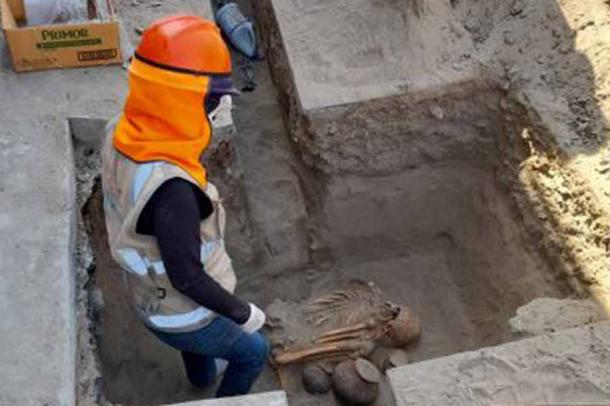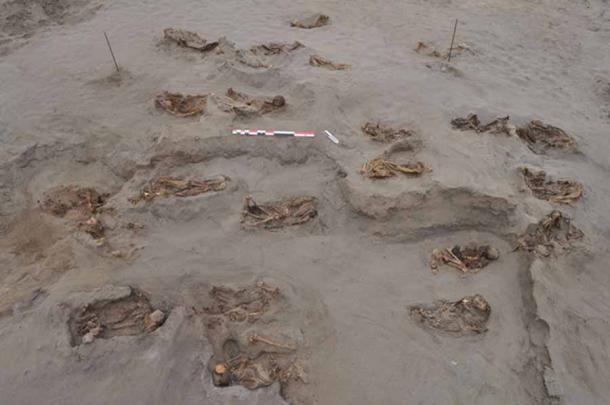Archaeologists in northern Peru have unearthed a rare Chimú culture body with three sacred vessels.
The Chimú culture existed from approximately 900 AD until 1470 AD and inhabited the northern coast of modern-day Peru, centered around their main settlement of Chan Chan . Last week, gas workers in the shanty town of Bolivar, in the city of Chimbote, in the Ancash region of northern Peru, unearthed a pre-Hispanic Chimú burial with three decorated vessels.
Assessing Differences Among The Chimú
The recent announcement of the discovery of a Chimú body comes in the same light as the spectacular 2006 discovery of the Moche culture Lady of Cao ‘: an ancient priestess or powerful ruler unearthed in the shanty town of San Pedro by archaeologist Regulo Franco Jordan of the El Brujo Archaeological Complex . Now, Juan Lopez Marchena, the head of the Decentralized Culture Directorate (DDC) of Chimbote , explained to the Andina news agency that the latest skeletal remains were found in a “flexed ventral ulna position.” (bent at the elbow and wrist).
Dr Lopez says that these new pre-Hispanic remains will be excavated and transported to the Max Uhle Museum in the city of Casma. By carefully studying the newly discovered body parts the researchers hope to calculate the person’s gender, what their diet consisted of and what their occupation was. And the archaeologist says this is a particularly important finding because each new Chimú grave illustrates “how rich and millenary different peoples in Chimbote were.”

The Chimú skeleton was found kneeling and bent over position. ( Andina)
The Ancient Chimú Trade Of Animal Based Artefacts
According to J. R. Topic’s 2003 paper published in the journal Latin American Antiquity, “ From stewards to bureaucrats: architecture and information flow at Chan Chan, Peru, ” Chan Chan developed a bureaucracy “due to the elite’s controlled access to information.” The city’s socio-economic system operated through the importation of raw wool from the guanaco, llama, alpaca, and vicuna, which the Chimú people spun into fabrics and garments. Embellishing their products with plant dyes and paints, feathers, brocades, embroidery and sometimes gold or silver plates, Chimú culture fabrics were highly-valued trade commodities in the ancient trading network of what is today Peru.

Chimú Tapestry Shirt, 1400–1540, Camelid fiber and cotton, Dumbarton Oaks Museum. ( Public Domain )
Three sacred clay burial vessels were discovered with the body which feature “circular designs,” which were very popular stylistic features on Chimú culture products. According to Lopez, inside the vessels archaeologists discovered evidence of the presence of “piruros,” which Chimu women used to spin wool-yarns. While in many ancient cultures circular designs represented the Sun, it is more probable these circles represented the moon, or lunar cycles, for similarly to the contemporary Muisca culture, of modern-day Colombia, for the Chimú the Moon was considered more powerful than the Sun.
Mass-Murder Under The Silvery Light Of The Moon
One aspect of the Chimú culture, which the Spanish conquistadors couldn’t forgive, was the mass-sacrifice of captive adult warriors at the Temple of the Moon , just a few miles from Chan Chan. However, this was way less horrific than the Chimú elite’s institutionalized killing of babies and children.
In a 2019 National Geographic article Dr Gabriel Prieto, a professor of archaeology from the National University of Trujillo , discussed a shocking discovery in Huanchaquito, a hamlet on the north coast of Peru. In 2011 he discovered the broken bodies of “269 children between the ages of five and 14.” More than 500 years ago these children were systematically murdered in “carefully orchestrated acts of ritual sacrifice that may be unprecedented in world history,” said Dr Preito.

A shocking number of children’s bodies have been found at Huanchaquito (© 2019 Gabriel Prieto et al / PLoS ONE )
Chan Chan’s sustained success depended on carefully managed irrigation systems and coastal fisheries. This means a severe El Niño weather event might have shaken the political and economic stability of the Chimú kingdom. It is thought that the priests and leaders may have ordered the mass sacrifice of these children in a desperate attempt to persuade the gods to stop the rains and flooding caused by an El Niño. Jane Eva Baxter, an anthropology professor at DePaul University , said the Chimú people probably considered their children as the most valuable offerings they could present to the gods and Dr Prieto said this number of children (269) would have been “a massive investment on behalf of the state”.
What this all means is that the Chimú people had played the ultimate “double-down.” As their culture was being torn apart and washed away in flood-waters, they sacrificed their children, which represented all hope of a future, to win favor in the spirit world. Child sacrifices, according to Dr Jane Eva Baxter, are “very carefully constructed negotiations and forms of communication with the supernatural.”
This newly discovered body will further illustrate the habits, diets and traditions of the Chimú people, in both life and death.
Top image: The Chimú burial recently uncovered in northern Peru. Source: Andina
By Ashley Cowie
Related posts:
Views: 0
 RSS Feed
RSS Feed

















 February 9th, 2021
February 9th, 2021  Awake Goy
Awake Goy  Posted in
Posted in  Tags:
Tags: 
















